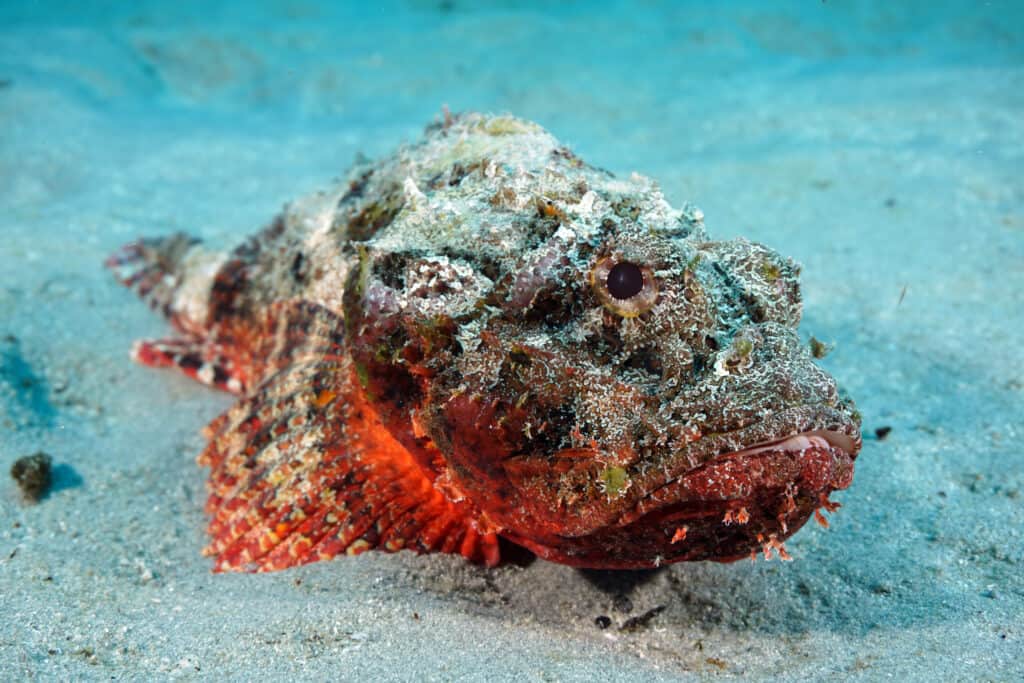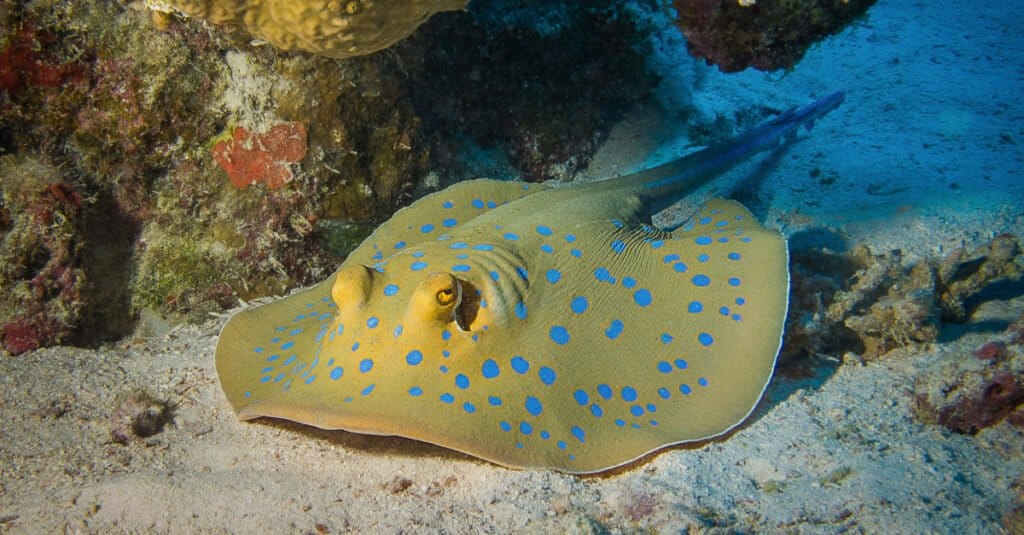The diversity of fish is astounding. They have the highest species variety of any group of vertebrates, with about 34,000 documented species. But this shouldn’t be so surprising. Afterall, water covers about 70% of the Earth’s surface. And fish reside in almost all aquatic habitats, including rivers, streams, kelp forests, coral reefs, and the open ocean. While most fish are perfectly harmless, some of them are venomous and can even be deadly. Let’s learn about 5 deadly types of venomous fish!
Fish Overview

Bull shark are among unique fish species that can survive in both freshwater and saltwater.
©Harry Collins Photography/Shutterstock.com
Coloration is one of the major ways fish are notably different. Some display vivid colors, like those adapted to dwell in coral reefs, such as parrotfish, triggerfish, and angelfish. Conversely, those inhabiting murky water, such as lungfish, are typically brown.
About half of the fish species live in oceans, while others reside in freshwater terrestrial ecosystems such as lakes, streams, and rivers. Few fish can handle both freshwater and saltwater because adjusting to the variations costs their bodies a lot of energy. However, American eels, bull sharks, salmon, and striped bass are unique fish species that can survive in fresh and saltwater.
Defense Mechanisms
Fish employ a range of strategies to protect themselves. To camouflage from predators and prey, they change color to blend with their environment. Most fish tend to counter-shade, featuring a light underbelly and a darker upper side. With this form of camo, the dark side melds with the bottom of the stream or pond when a predator views it from above, while the lighter part mimics the crystal-clear water surface when a predator views it from below. They can also change color depending on their moods. For example, a territorial fish can use a menacing coloration or pattern to keep out intruders.
Forming a school of hundreds or thousands of fish is another defense tactic. If a predator encounters a school of fish, the size of the group is enough to disorient it. However, the size and swimming ability of each fish must be roughly the same for this tactic to be effective.
They also use their senses (sound, sight, smell, taste, and touch) for survival. A peculiar sensory organ known as the lateral line helps them detect motion and vibration in water.
Some fish species have spines and fins all over their bodies used to fend off predators. For instance, sticklebacks deter predators with long spines on their backs and bellies.
Venomous Fish
For some fish, injecting venom is their primary protection mechanism. These venomous fish sting, bite, or stab their prey to inject toxic substances. About 2,500 fish species are venomous, with specific teeth and fin features, including opercular spines, cleithral spines, and fin spines. However, only 200 marine fish species are capable of stinging people, including stonefish, stingrays, toadfish, scorpionfish, weeverfish, zebrafish, blenny, catfish, ratfish, surgeonfish, and some sharks.
The most venomous freshwater fish are catfish, which have a worldwide distribution, and their envenomation is more severe than other species. Their venom is in a sheath close to three stringers in the dorsal and pectoral areas.
Freshwater stingrays also carry venom. They have one to four stingers on their tails that can inject venom into enemies, including humans, resulting in excruciating discomfort and necrosis of the skin.
According to studies, there is an equal distribution of venomous fish in freshwater and marine habitats. Most venomous fish species are non-migratory, slow-moving, and inhabit shallow waters in protected habitats.
Here’s a line-up of 5 deadly types of venomous fish:
1.) Stonefish

Stonefish are thick-set fish with small, upward-facing eyes, wide heads, fleshy pectoral fins, and wart-like bumps.
©Matt9122/Shutterstock.com
The infamous stonefish (Synanceia verrucosa), also known as reef stonefish, is one of the many fish species in the genus Synanceia within the family Scorpaenidae. It’s the most widely distributed stonefish species and holds the title of the most venomous fish in the ocean.
It belongs to the order Scorpaeniformes, making it a relative of a larger group of venomous fish known as Scorpionfishes. Lionfish, stingfish, lumpsuckers, and velvetfish are some other large, marine ray-finned fish family members.
Appearance
Stonefish are thick-set fish with small, upward-facing eyes, wide heads, fleshy pectoral fins, and wart-like bumps. There’s a large pit behind their eyes and a much smaller pit below them.
In contrast to the anal fin, which has three spines and five to six soft rays, the dorsal fin features 12 -14 spines and five to seven soft rays. The venom glands are at the base of the dorsal spines, which are equal in length and have a thicker skin sheath. Although this species can grow as long as 40 cm (16 inches), the average length and weight of this species are 27 cm (11 inches) and 2 kg (5 lbs.), respectively. They are also sexually dimorphic; female reef stonefish are larger than males.
Behavior
Typically, they sit motionless at the bottom of the sea, integrating nearly perfectly in form and color with the seafloor. They dwell in coral reefs and other marine habitats with rocky or muddy bottoms in the Indo-Pacific region.
You could be swimming close to a stonefish and wouldn’t even notice it. Their bodies are often brown with orange, yellow, or red spots, making them well camouflaged as a lump of coral or an encrusted rock. This camouflage ability comes in handy during hunting; stonefish wait for prey to swim by before launching a rapid attack and snatching it up. The attack can end in just 0.015 seconds.
Despite being the most venomous fish in the ocean, stonefish do not actually use their venom to kill prey. Rather, they are ambush predators who quickly pounce on their prey, mainly other reef fishes and some invertebrates living on the bottom. Stonefish are slow swimmers when not seeking a meal.
Stonefish live alone, but they have a promiscuous mating strategy. The oviparous females lay eggs on the seabed, and then males discharge sperm over them. The females allow any male to deposit sperm on the egg layer. The fertilized eggs will hatch reasonably fully formed.
The ability of stonefish to survive outside of water for as long as 24 hours is unusual among fish. They achieve this by taking in oxygen via their skin, but dehydration and suffocation may ultimately kill them.
Venom
There are 13 spines on the backs of stonefish, which, when pressed, emit venom. The venom contains toxic proteins, and it’s released when pressure is applied to the spines. This is good news, though. It indicates stonefish are not particularly motivated to target you for an attack. The venom is only deployed to defend itself against predators, but you want to be careful not to step on one.
Tissue death, paralysis, excruciating pain, and shock are some of the venom’s effects. In addition, humans, typically kids, the elderly, and those with compromised immune systems, can die from a big dose of venom.
2.) Stingray

The shallow ends of temperate and tropical waters are a typical habitat to find stingrays.
©normansava/Shutterstock.com
Stingrays are flat-bodied rays that belong to a superorder of cartilaginous fish closely related to sharks. They lack bones, like their shark relatives. Instead, cartilage acts as the body’s support. They are categorized as belonging to the suborder Myliobatoidei of the order Myliobatiformes. They are divided into eight families: freshwater stingrays, deepwater stingrays, round rays, sixgill stingrays, eagle rays, whiptail stingrays, butterfly rays, and stingarees.
The shallow ends of temperate and tropical waters are a typical habitat to find stingrays. They are primarily motionless, half hidden in the sand, and often only move in response to the tide. Most stingrays swim through undulatory locomotion when in the mood to move; other stingrays flap their sides like wings.
Appearance
They are usually camouflaged from larger rays and predatory sharks by their color, which tends to reflect the shade of the seafloor.
They have pectoral fins attached to their heads, trunks, and a famed tail that trails behind. The tail’s main function is defense, though it can also be used to move around in the water. Their mouth, gill slits, and nose are under their bellies, while their eyes are visible from the dorsal side. Thus, scientists think they use their eyes sparingly when hunting.
They feature electrical sensors known as ampullae of Lorenzini, as sharks do. The sensors are useful for hunting and reproduction. These sensory organs around the stingray’s mouth detect the electrical charges that potential prey naturally carry. Mature male stingrays use their ampullae of Lorenzini to detect specific electrical signals from adult females before possible copulation.
They consume crabs, mussels, oysters, clams, and shrimp, using their powerful jaws to break up their prey when they discover it.
Venom
The spines at the back of a stingray’s tail carry venom, which can be injected into a victim’s foot or leg. There is a higher chance of infection if pieces of the spine’s covering remain inside the wound. An attack typically results from stepping on a stingray while diving in the ocean.
3.) Red Lionfish

You can’t miss the conspicuous maroon, red, or brown stripes interspersed with white stripes on a red lionfish (Pterois volitans). The invasive species are found in the United States, with a growing population and increased geographic range. Lionfish reproduce year-round and have no known predators.
It’s indigenous to the coral reefs of the Indo-Pacific region. But, it has been introduced to warm water ecosystems like the Caribbean Sea, Western Atlantic, and northern Gulf of Mexico as an invasive species.
Appearance
Adults can reach about 18 inches long, while the young are usually no longer than 1 inch (2.5 cm). They have 13 long and separated dorsal spines, three anal spines, six to seven anal soft rays, and 10-11 dorsal soft rays. They also have fan-like pectoral fins and fleshy tentacles below and above their mouths. The name “lionfish” comes from the combination of their fins that give the fish a mane-like look.
Lionfish can live for as long as 10 years; they rely on their unique coloration and dorsal spines to ward off potential predators. They primarily hunt fish and shrimp with camouflage and speedy reflexes.
Venom
The red lionfish’s venom is mainly defensive and is transmitted through its sharp dorsal fins. Humans stung by lionfish experience unbearable pain, nausea, and respiratory problems. However, people usually survive its sting.
4.) Zebra Surgeonfish

This fish identifies as a surgeonfish due to the pointed, angular, scalpel-like tail at the bottom of the caudal fin.
©iStock.com/Katherine OBrien
This fish (Acanthurus lineatus) is an algae-primarily feeder that thrives in the shallow waters of coral reefs. Many other names, such as lined surgeonfish, pyjama tang, clown surgeonfish, and blue-banded surgeonfish know it. But it identifies as a surgeonfish.
Appearance
It features a pointed, angular, scalpel-like tail at the bottom of the caudal fin. In addition, the caudal peduncle features venomous, sharp, and forward-facing spines. It has a gray belly, but most of the body is covered in black-edged blue and yellow stripes. Darkened rays are on the pectoral fins, while the pelvic fins are yellow brown with black edges.
They are aggressively territorial, with a mature male guarding a feeding area and a group of female surgeonfish. While the young are solitary, adults congregate in numbers during spawning and may form a school.
Poison
Although the surgeonfish is edible, it can occasionally result in a rare food poisoning known as ciguatera, making you feel itchy, uncomfortable, or numb in your face while causing hypotension and a slow heartbeat.
5.) Stargazer

They typically hide in the sand and spring to the surface to capture prey.
©Ethan Daniels/Shutterstock.com
Stargazers are reportedly one of the meanest fish species in the ocean. They owe their name to their odd and distinctive eyes, which sit atop their head.
Appearance and Behavior
Stargazers also have upturned mouths and large, flat heads. They typically hide in the sand and spring to the surface to capture prey. Some species use a worm-shaped lure that grows from the bottom of their lips to draw prey’s attention. They mainly eat smaller fish and crustaceans.
They aren’t the only fish species with electrical discharge, but they are the only electric fish without specialized electroreceptors, which means they do not use electricity to seek prey. Instead, they can generate and expel up to 50 volts of electricity.
Venom
True to their reputation, stargazers are venomous, though not as potent as stonefish and scorpionfish. Their venom is produced by two large spines located right above their pectoral fins. The venom doesn’t kill but can inflict shock, localized swelling, and severe pain.
Venom Vs. Poison
Understanding the difference between venomous and poisonous fish is essential to guide your encounters with them. Venom is injected while poison is ingested.
Typically, venomous fish use their spines to pierce a victim and inject venom. However, poisonous fish contain deadly toxins, making them harmful to consume.
The photo featured at the top of this post is © bearacreative/Shutterstock.com
Thank you for reading! Have some feedback for us? Contact the AZ Animals editorial team.






